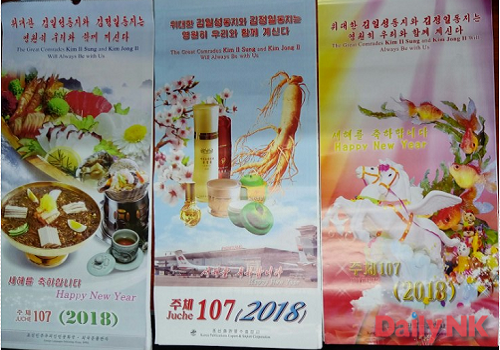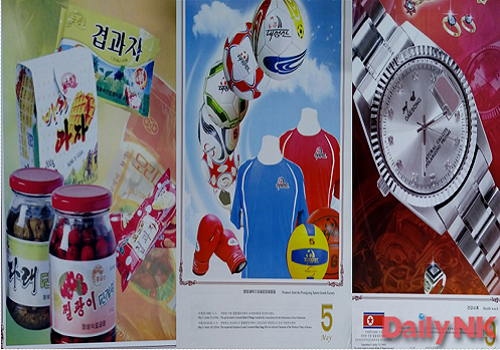Unification Media Group (UMG): We’ve now reached 2018 and many of us have placed new calendars on our desks or hung them on our walls. And just across the border to the north, many have done the same. Today we continue our discussion on the 2018 official state calendars of North Korea with special correspondent Kang Mi Jin.
Kang Mi Jin (Kang): Thanks very much! Yes, people in North Korea are also hanging up their 2018 calendars. There’s a variety of options available this year, including ones containing images of food, ceramics, movie stars, landscapes, and other topics. Some of the more unique items to appear in this year’s calendars are the various domestically-produced products being shown off by the authorities, such as smartphones, cosmetics, sports equipment, and medicines.
UMG: Tell us a bit more about them.
Kang: First there are the food calendars, produced by the Foreign Languages Publishing House, which contain English image descriptions next to the Korean, even for the ones sold inside North Korea. One includes images of “Pyongyang naengmyeon” (cold noodles) and “sora” (conch shellfish) – two local Pyongyang dishes – as well as steamed jumbo shrimp and even a large roast turkey.
There is grilled eel over rice in the Japanese style, glutinous rice cakes, oxtail soup, and other delicacies. Besides these rather rare and mostly uncommon foods, there are also things ordinary people would know, like grilled mushrooms, grilled pork, grilled abalone salad, and samgyeopsal (grilled pork belly) lettuce wraps.
I have heard people talking a lot about all the food appearing in the calendars this year, and saw at least 3 different food calendars myself.
UMG: What about some of the other calendars?
Kang: The Foreign Languages Publishing House also published a calendar filled with products meant to display the achievements of the Kim Jong Un system. It includes Taedonggang Beer, Bomhyanggi (scent of spring) cosmetics, laundry detergent, ginseng, and other domestic products. It provides a glimpse of the products that North Korea may be hoping to export.
The cosmetic products look as if they could be from South Korea, with perfume, lotion, lipstick, and other things presented as luxurious items. There is also Korean red ginseng extract, tea, and other health products, all with trademarks on the packaging in an effort to boost the perception of the products.
There are also shoes of the Maebongsan brand, which are best known for being produced in a factory in Wonsan that Kim Jong Un visited and began promoting last year. Other shoe products include summer sandals for women and dress shoes for men, again looking like something from a South Korean catalog.
UMG: Can these be taken as signs of development in light industry in North Korea?
Kang: Yes, at least people inside North Korea are saying as much. One person with whom I recently spoke living in Pyongyang said that she has seen some of the items from the calendar showing up in the local markets these days, and that they weren’t just hollow mock-ups.
But they’re not all positive reactions. Regarding some of the other items that appear to be targeted only towards export markets for foreign currency-earning, some people are openly acknowledging that the items are not intended for locals and that they may not be able to find them.
UMG: Which types of calendars are most popular in North Korea now?
Kang: Though of course it depends on a person’s own interests, it seems that people are trying to get their hands on the newest kinds, or those that are unique and can’t easily be found on their friends’ walls, for example.
Up until the 2000s when I left for South Korea, the most popular calendars were the ones with pictures of movie stars. Most people wanted to buy these particular ones depicting the actors and singers who were known as national heroes. Then in the 2010s, nature and landscape calendars became popular as well.
But things are changing a bit these days. Now there’s a greater variety of calendar types and subjects, and people’s preferences are changing. In 2017, the most popular ones were the food, snack, and candy calendars, although the celebrity calendars remained popular as well. Another one which people find new and unique is the fruits calendar, depicting pears, strawberries, grapes, and kiwis, which they call ‘king darae’ (meaning a bigger darae, a native Korean fruit similar to the kiwi).
UMG: How much do these calendars cost in the markets?
Kang: The most popular time to purchase a calendar is at the end of the year, up until around mid-January. Prices are highest at the very end of December, at around 20,000 KPW (2.50) USD. Those without much money or trying to save money will wait until February when the prices go down.
UMG: Thank you again for the fascinating insights!























